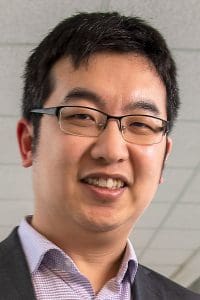The solution to better hearing isn’t simply turning up the volume on a speaker – or a hearing aid. Sorting through a broad range of sounds to amplify only those someone wants and needs to hear is far more complex than simply making something louder.
Mi Zhang and his team of researchers in Michigan State’s department of electrical and computer engineering are working to make hearing aids smarter. It’s one of those ideas that causes people to say, “Why didn’t someone think of that sooner?” But the physical size of the technology involved erases all hope for a simple solution.
 “People who need hearing aids are also relying on other information to hear better,” Zhang said. “They’re reading lips, they’re looking for physical cues. If there is a delay in processing the audio, if those two sources don’t sync, it makes you dizzy. It’s like the captioning being out of sync with the action in a movie.”
“People who need hearing aids are also relying on other information to hear better,” Zhang said. “They’re reading lips, they’re looking for physical cues. If there is a delay in processing the audio, if those two sources don’t sync, it makes you dizzy. It’s like the captioning being out of sync with the action in a movie.”
To create this smart hearing aid, Zhang and his team are focusing on two key components of the technology:
- They needed to develop an AI-based algorithm to identify which noises to filter out and which to keep. Background conversations and utensils clanking in a noisy restaurant, for instance, should become muted. But when a person is driving, it’s important to be able to hear road noise or sirens.
- The compression of the data needed to happen nearly instantly – in 10 milliseconds or less – so the audio can sync up with the delivery source.
Once those pieces are achieved, there is yet another hurdle: Fitting the technology into a tiny device that tucks inside the ear.
“Because it’s a miniature, wearable device, a hearing aid has limited compute resources,” Zhang said. “And you don’t want to make your device so heavy that you’re constantly processing the signal. That generates heat and burns your ear. So, it has to be really lightweight.”
Perhaps that’s why no one has done this before.
But Zhang and his team are making significant headway with this innovation. In fact, they have two algorithms ready for marketing – the acoustic and the compression pieces. Up next: Integrating them into the hardware of the hearing aid. To do that, the technology needs to move into the marketplace.
“The MSU Innovation Center helped me file a patent application, which has been really helpful,” Zhang said. They’ve actually filed seven so far, he said, and he credits the Innovation Center – especially Ray DeVito and Frank Urban – with making the process smooth and understandable.
“There are a lot of things I don’t know in the commercial world, and they’re giving me business 101 and marketing 101 to help me understand the basics of business technology so I can see a more comprehensive picture that combines the technology to create a better plan,” Zhang said.
With more than 35 million children and adults in the United States experiencing some degree of hearing loss, according to the FDA, Zhang’s smart hearing aid has tremendous potential for widespread benefit. “I’m thankful for the help of the Innovation Center and MSU Technologies,” Zhang said. “They’re constantly helping me and they’re appreciative of my work. I hope others in the market can appreciate my work the way MSU does.”
